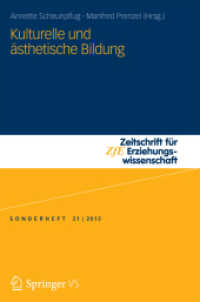Full Description
In WEAPONS OF MASS DESTRUCTION AND TERRORISM, 2/e, Dr. James Forest and Brigadier General (Retired) Russell Howard have collected original and previously published seminal articles and essays by scientists, academics, government officials, and members of the nation's security and intelligence communities. The editors and several of the authors write from practical field experience in nonproliferation and counterterrorism efforts. Others have had significant responsibility for developing government policies to address the threat of weapons of mass destruction and terrorism. The contributors include many significant names in the field including Bruce Hoffman, Ashton Carter, William Perry, Brian Jenkins, Jonathan Tucker, Charles Ferguson, David Albright, Gary Ackerman, and Gregory Koblentz.Unit I of the book introduces key terms and addresses important strategic and policy debates. Authors explain how the new forms of terrorism affect the post-9/11 security environment and how weapons of mass destruction could give terrorists short-term, asymmetric attack advantages over conventional military forces. Unit II offers detailed accounts of the characteristics, availability, and dangers of specific types of WMD, along with five case studies that associate theory with practice-an important feature of this volume. Unit III is focused on key dimensions of the WMD threat to critical infrastructure. Unit IV deals with past, present, and future national and international responses to-and defenses against-the threat of WMD terrorism. And in the final section of the volume, authors provide several analytical frameworks for predicting future WMD threats, and draw from historical events to identify lessons and strategies for the future. Appendices include U.S. national strategy documents on countering terrorism and standards for controlling WMD materials and technologies.
Contents
Weapons of Mass Destruction and Terrorism, Second EditionForeword Michael A. SheehanPrefaceUnit One-Conceptual FrameworksIntroduction1.1 Definitions, Trends, and the Concept of "New Terrorism"Russell D. Howard and Margaret J. Nencheck The New TerrorismBrian Michael Jenkins The New Age of Terrorism1.2 The Nature of the Post-9/11 WMD Terrorism ThreatBruce Hoffman CBRN Terrorism Post-9/11James J. F. Forest Opportunities and Limitations for WMD TerrorismLeonard A. Cole WMD and Lessons from the Anthrax AttacksUnit Two-Weapons and MotivationsIntroduction2.1 Chemical WeaponsNational Academies and Department of Homeland Security Fact Sheet: Chemical Warfare Agents, Industrial Chemicals, and ToxinsJonathan B. Tucker Chemical Terrorism: Assessing Threats and Responses2.2 Biological WeaponsNational Academies and Department of Homeland Security Fact Sheet: Human Pathogens, Biotoxins, and Agricultural ThreatsJames W. Martin, George W. Christopher, and Edward M. Eitzen History of Biological Weapons: From Poisoned Darts to Intentional EpidemicsBrian Finlay The Bioterror Pipeline: Big Pharma, Patent Expirations, and New Challenges to Global SecurityBenjamin Wittes Innovation's Darker Future: Biosecurity, Technologies of Mass Empowerment, and the Constitution2.3 Radiological WeaponsNational Academies and Department of Homeland Security Fact Sheet: Dirty Bombs and Other DevicesCharles D. Ferguson and Michelle M. Smith Assessing Radiological Weapons: Attack Methods and Estimated Effects2.4 Nuclear WeaponsNational Academies and Department of Homeland Security Fact Sheet: Nuclear WeaponsMorten Bremer Maerli, Annette Schaper, and Frank Barnaby The Characteristics of Nuclear Terrorist WeaponsMatthew Bunn and Anthony Wier The Seven Myths of Nuclear TerrorismJohn Mueller The Atomic Terrorist?2.5 Case StudiesDavid Albright and Corey Hinderstein Unraveling the A.Q. Khan and Future Proliferation NetworksJeffrey M. Bale The North Caucasus Conflict and the Potential for Radiological TerrorismRobert Jones, Brandon Wills, and Christopher Kang Chlorine Gas: An Evolving Hazardous Material Threat and Unconventional WeaponUnit Three-Critical Infrastructure DimensionsIntroduction3.1 Public Spaces, Transportation Networks, and Other Critical InfrastructureGary A. Ackerman, Jeffrey M. Bale, and Kevin S. Moran Assessing the Threat to Critical InfrastructureHomeland Security & Defense Business Council Mass Transit Security3.2 Chemical and Biological ThreatsJohn McNabb Chemical and Biological Threats against Public Water SystemsMark Wheelis, Rocco Casagrande, and Laurence V. Madden Biological Attack on Agriculture: Low-Tech, High-Impact Bioterrorism3.3 Nuclear ReactorsGavin Cameron Nuclear Terrorism: Reactors & Radiological Attacks after September 11George Bunn and Chaim Braun Terrorism Potential for Research Reactors Compared with Power Reactors: Nuclear Weapons, "Dirty Bombs," and Truck BombsUnit Four-Responding to the ThreatIntroduction4.1 Strategy and PolicyMary Beth Nikitin, Paul K. Kerr, and Steven A. Hildreth Proliferation Control Regimes: Background and StatusAlbert J. Mauroni A Counter-WMD Strategy for the FutureRussell D. Howard Preemptive Military Doctrine: No Other Choice4.2 IntelligenceMatthew C. Waxman Self-Defense and the Limits of WMD IntelligenceBrian Finlay Minding Our Business: The Role of the Private Sector in Managing the WMD Supply Chain4.3 Response and ResilienceAshton B. Carter, Michael M. May, and William J. Perry The Day After: Action Following a Nuclear Blast in a U.S. CityRonald W. Perry and Michael K. Lindell Understanding Citizen Response to Disasters with Implications for Terrorism4.4 Unique Challenges of Responding to Bioterrorism Threats and AttacksLea Ann Fracasso Developing Immunity: The Challenges of Mandating Vaccinations in the Wake of a Biological Terrorist AttackCrystal Franco and Nidhi Bouri Environmental Decontamination Efforts Following a Large-Scale Bioterrorism Attack: Federal Progress and Remaining GapsGregory D. Koblentz and Jonathan B. Tucker Tracing an Attack: The Promise and Pitfalls of Microbial ForensicsSam Berger and Jonathan D. Moreno Public Trust, Public Health, and Public Safety: A Progressive Response to Bioterrorism4.5 Case StudiesDavid Albright, Paul Brannan, and Andrea Scheel Stricker Detecting and Disrupting Illicit Nuclear Trade after A.Q. KhanElin Gursky, Thomas V. Inglesby, and Tara O'Toole Anthrax 2001: Observations on the Medical and Public Health ResponseRobyn Pangi Consequence Management in the 1995 Sarin Attacks on the Japanese Subway SystemXavier Stewart An All-Hazards Training Center for a Catastrophic EmergencyUnit Five-Assessing the Future WMD ThreatIntroduction5.1 Gregory D. Koblentz Predicting Peril or the Peril of Prediction? Assessing the Risk of CBRN Terrorism5.2 Joshua Sinai and James J.F. Forest Threat Convergence: A Framework for Analyzing the Potential for WMD Terrorism5.3 Forrest E. Waller, Jr. and Michael A. George Emerging WMD Technologies5.4 Adam Dolnik and James J.F. Forest Conclusion: Appreciating the Past and Present, Anticipating the FutureAppendixA.1 Prevention of WMD Proliferation and Terrorism Report Card (January 2010)A.2 National Strategy for Counterterrorism (June 2011)A.3 A National Strategy for CBRNE Standards (May 2011)CreditsIndexNER(01): WOW








